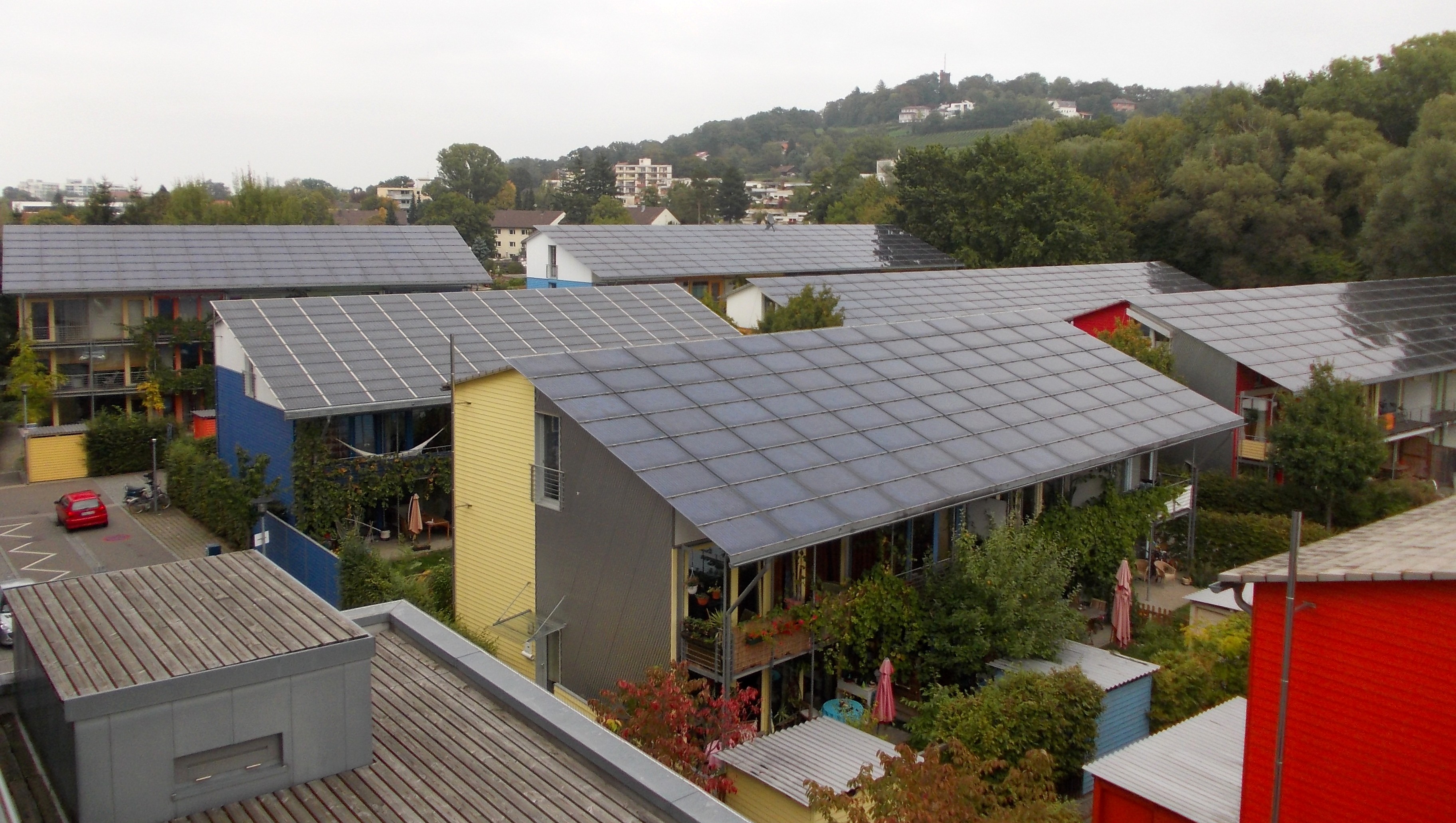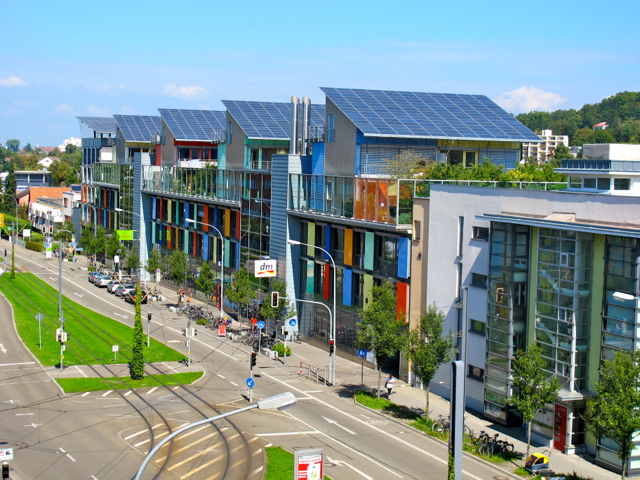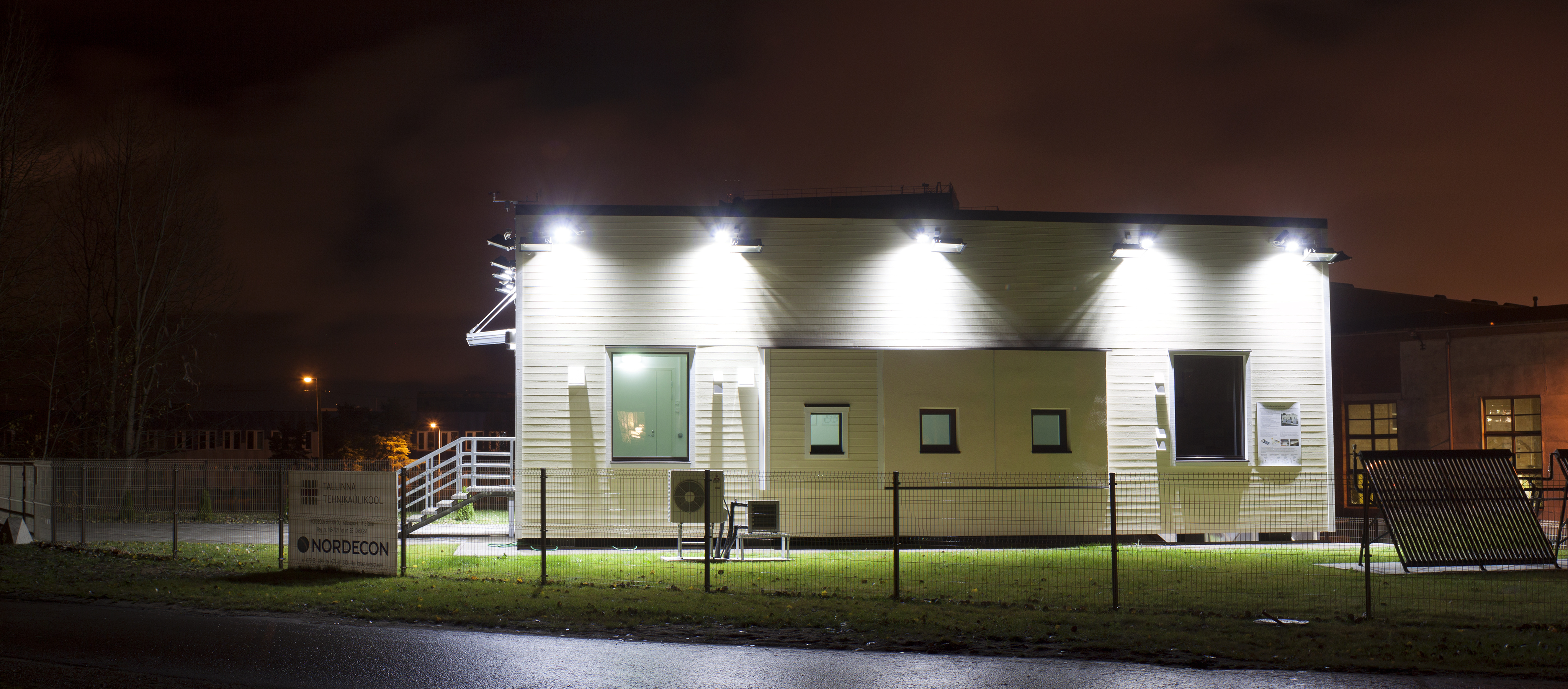|
Energy-plus Building
An energy-plus building (also called: plus-energy house, efficiency-plus house) produces more energy from renewable energy sources, over the course of a year, than it imports from external sources. This is achieved using a combination of microgeneration technology and low-energy building techniques, such as: passive solar building design, insulation and careful site selection and placement. A reduction of modern conveniences can also contribute to energy savings, however many energy-plus houses are almost indistinguishable from a traditional home, preferring instead to use highly energy-efficient appliances, fixtures, etc., throughout the house. "Plusenergihuset" (the plus energy house) was the Danish term used by Jean Fischer in his publication from 1982 about his own energy-plus house. PlusEnergy is a brand name, used by Rolf Disch, to describe a structure that produces more energy than it uses. The term was coined by Disch in 1994 when building his private residence, the He ... [...More Info...] [...Related Items...] OR: [Wikipedia] [Google] [Baidu] |
Freiburg 071ss
Freiburg im Breisgau (; abbreviated as Freiburg i. Br. or Freiburg i. B.; Low Alemannic German, Low Alemannic: ''Friburg im Brisgau''), commonly referred to as Freiburg, is an independent city in Baden-Württemberg, Germany. With a population of about 230,000 (as of 31 December 2018), Freiburg is the List of cities in Baden-Württemberg by population, fourth-largest city in Baden-Württemberg after Stuttgart, Mannheim, and Karlsruhe. The population of the Freiburg metropolitan area was 656,753 in 2018. In the Southern Germany, south-west of the country, it straddles the Dreisam river, at the foot of the Schlossberg (Freiburg), Schlossberg. Historically, the city has acted as the hub of the Breisgau region on the western edge of the Black Forest in the Upper Rhine Plain. A famous old German university town, and Roman Catholic Archdiocese of Freiburg, archiepiscopal seat, Freiburg was incorporated in the early twelfth century and developed into a major commercial, intellectual, an ... [...More Info...] [...Related Items...] OR: [Wikipedia] [Google] [Baidu] |
Sun Ship (building)
''Sonnenschiff'' () is a large integrated office and retail building in Freiburg im Breisgau, Germany. It was built in 2004 in the city's Vauban quarter as part of the Solar Settlement at Schlierberg. Sonnenschiff was designed by the architect Rolf Disch (who also built the Heliotrope building) and generates four times more energy than it uses. As a whole this building produces more energy than it consumes per year and utilizes the most up-to-date building technology. Some aspects that make this building particular are its vacuum insulated walls, ventilation with 95% heat recovery, triple paned windows and its energy façade. It is the first positive energy office building worldwide. The office spaces are flanked on both the East and West sides entirely with windows, which maximizes natural lighting and employee views while it minimizes the energy used for artificial lighting. Sonnenschiff includes a supermarket, convenience store and bakery-café on the first floor, offices ... [...More Info...] [...Related Items...] OR: [Wikipedia] [Google] [Baidu] |
Passive House
"Passive house" (german: Passivhaus) is a voluntary standard for energy efficiency in a building, which reduces the building's ecological footprint. It results in ultra-low energy buildings that require little energy for space heating or cooling. A similar standard, MINERGIE-P, is used in Switzerland. The standard is not confined to residential properties; several office buildings, schools, kindergartens and a supermarket have also been constructed to the standard. The design is not an attachment or supplement to architectural design, but a design process that integrates with architectural design. Although it is generally applied to new buildings, it has also been used for refurbishments. In 2008, estimates of the number of passive house buildings around the world ranged from 15,000 to 20,000 structures. In 2016, there were approximately 60,000 such certified structures of all types worldwide. The vast majority of passive structures have been built in German-speaking countri ... [...More Info...] [...Related Items...] OR: [Wikipedia] [Google] [Baidu] |
Autonomous Building
An autonomous building is a building designed to be operated independently from infrastructural support services such as the electric power grid, gas grid, municipal water systems, sewage treatment systems, storm drains, communication services, and in some cases, public roads. Advocates of autonomous building describe advantages that include reduced environmental impacts, increased security, and lower costs of ownership. Some cited advantages satisfy tenets of green building, not independence per se (see below). Off-grid buildings often rely very little on civil services and are therefore safer and more comfortable during civil disaster or military attacks. For example, Off-grid buildings would not lose power or water if public supplies were compromised. As of 2018, most research and published articles concerning autonomous building focus on residential homes. In 2002, British architects Brenda and Robert Vale said that It is quite possible in all parts of Australia to ... [...More Info...] [...Related Items...] OR: [Wikipedia] [Google] [Baidu] |
Low Energy Building
Low-energy buildings, which include zero-energy buildings, passive houses and green buildings, may use any of a large number of techniques to lower energy use. The following are some of the techniques used to achieve low-energy buildings, which excludes energy generation (microgeneration). Improvements to building envelope * Active daylighting * Barra system * Brise soleil * Cool roof and green roof * Daylighting * Double envelope house * Earth sheltering * Energy plus house * Fluorescent lighting, compact fluorescent lamp, and LED lighting * History of passive solar building design * Low-energy house * Passive daylighting * Passive house * Passive solar * Passive solar building design * Quadruple glazing * Solar energy * Superinsulation * Sustainable architecture * Sustainability * Trombe wall * Windcatcher * Zero energy building * Zero heating building Improvements to heating, cooling, ventilation and water heating * Absorption refrigerator * Annualized geothermal solar * Ea ... [...More Info...] [...Related Items...] OR: [Wikipedia] [Google] [Baidu] |
Zero Heating Building
Zero-heating building or nearly zero-heating building (nZHB) is a building having essentially zero heating demand, defined as having heating demand, Q’NH, less than 3 kWh/(m2a). The zero-heating building is intended for use in heating-dominated areas. The purpose of the zero-heating building is to supersede net-zero energy buildings as a way to bring building-related greenhouse gas emissions to zero in the EU. Zero-heating buildings address flawed net-zero energy buildings: the requirement for seasonal energy storage, in some cases poor comfort of living and narrow design options. Concept and approach Seasonal energy storage problem In areas where there is substantial heating demand, it is hard to fill this demand with renewable power as in heating season, solar power is in short supply. This means heating in highly urbanized areas is directly or indirectly powered by, in a large part from fossil sources. About 2000 TWh of seasonal energy storage is needed to meet EU's winter ... [...More Info...] [...Related Items...] OR: [Wikipedia] [Google] [Baidu] |
Zero Energy Building
A Zero Energy Building (ZEB), also known as a Net Zero Energy (NZE) building, is a building with net zero energy consumption, meaning the total amount of energy used by the building on an annual basis is equal to the amount of renewable energy created on the site or in other definitions by renewable energy sources offsite, using technology such as heat pumps, high efficiency windows and insulation, and solar panels. The goal is that these buildings contribute less overall greenhouse gas to the atmosphere during operations than similar non-ZNE buildings. They do at times consume non-renewable energy and produce greenhouse gases, but at other times reduce energy consumption and greenhouse gas production elsewhere by the same amount. The development of zero-energy buildings is encouraged by the desire to have less of an impact on the environment, and by tax breaks and savings on energy costs that make zero-energy buildings financially viable. Terminology tends to vary between cou ... [...More Info...] [...Related Items...] OR: [Wikipedia] [Google] [Baidu] |
Vauban, Freiburg
Vauban () is a neighbourhood (''Stadtteil'') to the south of the town centre in Freiburg, Germany. It was built as "a sustainable model district" on the site of a former French military base named after Sébastien Le Prestre de Vauban, the 17th century French Marshal who built fortifications in Freiburg while the region was under French rule. Construction began in 1998, and the first two residents arrived in 2001. History The site was originally developed as a military base in 1936 and was taken over after World War II by the French forces occupying the region. The military left in 1992. Over a period of some years the vacant structures were occupied by various tribes of hippies and anarchists. Following battles with the city government, squatters won the rights to four of the original twenty barracks. At the same time a group called "Forum Vauban" was pressing the City Council to develop the site in an eco-friendly way. The remaining 38 hectares were acquired by Freiburg City C ... [...More Info...] [...Related Items...] OR: [Wikipedia] [Google] [Baidu] |
Bavaria
Bavaria ( ; ), officially the Free State of Bavaria (german: Freistaat Bayern, link=no ), is a state in the south-east of Germany. With an area of , Bavaria is the largest German state by land area, comprising roughly a fifth of the total land area of Germany. With over 13 million inhabitants, it is second in population only to North Rhine-Westphalia, but due to its large size its population density is below the German average. Bavaria's main cities are Munich (its capital and largest city and also the third largest city in Germany), Nuremberg, and Augsburg. The history of Bavaria includes its earliest settlement by Iron Age Celtic tribes, followed by the conquests of the Roman Empire in the 1st century BC, when the territory was incorporated into the provinces of Raetia and Noricum. It became the Duchy of Bavaria (a stem duchy) in the 6th century AD following the collapse of the Western Roman Empire. It was later incorporated into the Holy Roman Empire, became an ind ... [...More Info...] [...Related Items...] OR: [Wikipedia] [Google] [Baidu] |
Hilpoltstein
Hilpoltstein () is a town in the district of Roth, in Bavaria, Germany. It is situated 10 km southeast of Roth bei Nürnberg and 30 km south of Nuremberg, close to the lake 'Rothsee. History * Origins of the castle and the town date back to the 10th century. * Town privileges were granted in 1354. * 1799, Hilpoltstein becomes part of Bavaria Sights * Rathaus (Town Hall) * Accessible Tower of the Remains of the early medieval Castle * Remains of The Town Wall * Church of Saint John the Baptist (Town's Parish Church) * Jahrsdorfer House * Guest House 'Schwarzes Ross' with historic Brewery and museum on handcrafts and town history Sons and daughters of the place * Johann Christoph Sturm (1635–1703), astronomer and mathematician * Friedrich Eibner (1825–1877), painter People who work or have worked on the ground * Ludwig Elsbett (1913–2003), engineer and inventor of the Elsbett engine Annual Events * Spring Concert of the town's brass band (April) * Medieval festival with ... [...More Info...] [...Related Items...] OR: [Wikipedia] [Google] [Baidu] |
Offenburg
Offenburg ("open borough" - coat of arms showing open gates; Low Alemannic German, Low Alemmanic: ''Offäburg'') is a city located in the state of Baden-Württemberg, Germany. With nearly 60,000 inhabitants (2019), it is the largest city and the administrative capital of the Ortenaukreis. History In recent times the remains of Roman settlements have been found within the city's territory. Offenburg was first mentioned in historical documents dating back to 1148. Offenburg had already been declared a Free Imperial City by 1240. In September 1689, the city - with the exception of two buildings - was totally destroyed by the French during the Nine Years War. Due to Napoleon's dissolution of the Holy Roman Empire in 1803 and subsequent reorganization of the German states, Offenburg lost its status as a Free Imperial City and fell under the rule of the Grand Duchy of Baden. During the outbreak of the Revolutions of 1848 in the German states#Baden, Revolutions of 1848, the "''Offenbur ... [...More Info...] [...Related Items...] OR: [Wikipedia] [Google] [Baidu] |
Hansgrohe
Hansgrohe SE is a German sanitary fittings manufacturer. It was founded by Hans Grohe in 1901, in Schiltach, Baden Wuerttemberg, Germany. Hansgrohe is one of the world's largest shower head, hand shower and tap suppliers, next to competitors such as Grohe and Kohler. Principal shareholder is the Masco Corporation, Taylor, Michigan, United States. Hansgrohe is not to be confused with the Grohe AG, another German sanitary fittings manufacturer, which was founded by Hans Grohe's son Friedrich. Background Hansgrohe has two major shareholders: The family of Klaus Grohe, the founders’ youngest son, holds 32%, Masco Corporation 68%. Hans Jürgen Kalmbach became chairman of Hansgrohe in 2018. The company sells its products under two brand names: Axor and hansgrohe. In 2017, Hansgrohe reported sales of 1.077 billion Euro (2016: 1.029 billion Euro). The company employs about 4,962 people, 40% outside of Germany. Hansgrohe manufactures its products in factories in the United States, Germ ... [...More Info...] [...Related Items...] OR: [Wikipedia] [Google] [Baidu] |

_4029.jpg)






